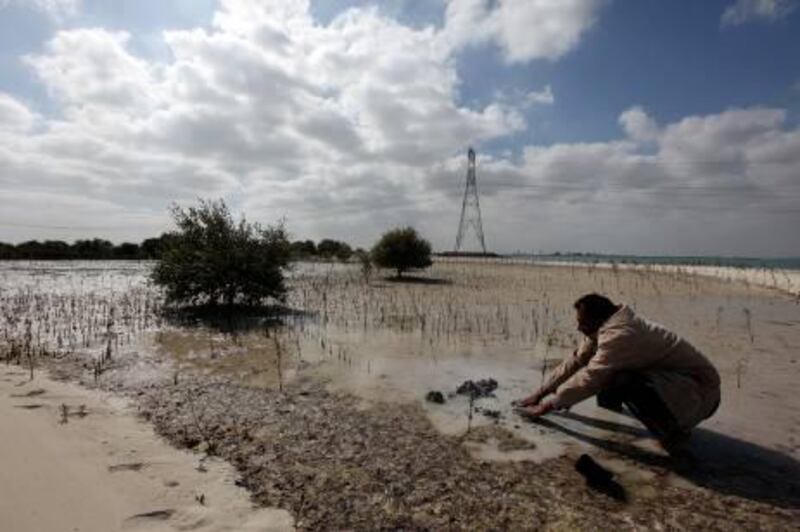ABU DHABI // As the last of 800,000 mangrove saplings were added to a reforestation effort along the capital's coastline yesterday, environmental officials pledged that more of the indigenous trees will be planted throughout the emirate.
Plans by the Environment Agency - Abu Dhabi (EAD) to restore mangrove habitats that have been affected by development will be extended to coastal areas in the Western Region, and to Ghantoot by the Dubai border, officials said.
Since official record keeping on mangrove habitats in Abu Dhabi began in 2001, EAD has recorded the loss of 20 square kilometres to make room for coastal developments.
"Mangroves were once everywhere in Abu Dhabi," said Dr Thabit al Abdessalaam, the EAD director of biodiversity management.
Officials estimate that Abu Dhabi has 72 sq km of mangrove habitat, second in the region only to Iran, which has about 90 sq km.
The rehabilitation work that finished yesterday began in November 2009 and involved planting 800,000 saplings on Jubail Island. Jubail is located off Saadiyat Island, which is under development by the Tourism Development and Investment Company (TDIC) to become the capital's cultural district.
The TDIC also ran a separate mangrove-planting effort that produced about a million saplings since spring 2008, on Saadiyat and elsewhere around the capital.
Dr al Abdessalaam said the reforestation effort had to be carefully planned so that the seedlings - of the Avicennia marina, or black mangrove, variety - stood a good chance of success.
"We did not want to dredge to create channels," he said. "We had to make sure that only areas that had water inundation would be planted."
The team conducted surveys of the area from the air and on the ground to ensure that any planting would not destroy salt marshes and mudflats, which are also important natural habitats.
Yesterday the first of the 800,000 saplings planted, now a year old, appeared to be thriving. They had grown to about 60 centimetres, with their roots - which need exposure to air to breathe - clearly visible sticking up from the sand. The muddy shore on which the mangroves had been planted was full of gastropods, a type of mollusc that serves as a food source for birds, part of the ecosystem that mangroves help to sustain.
"These were not here before we planted the mangroves," Dr Himansu Das, a scientist with the EAD, said.
Besides providing food and shelter for many species of birds, mangroves are also important nurseries for healthy fisheries, with many species of fish and invertebrates such as shrimp starting their lives in the calm, nutrient-rich waters of mangrove swamps.
While more mangroves are to be planted in Ghantoot, Mirfa and Tareef in the Western Region, the EAD has not yet decided when the work will start or how many trees there will be.
"The goal is not to increase areas of mangroves," Dr al Abdessalaam said. "The goal is to restore the habitat, to mitigate and reduce the effects of coastal development."
vtodorova@thenational.ae
Thousands of mangroves planted in Abu Dhabi, and more to come
Western Region and Ghantoot will be next now that Jubail Island planting is complete and year-old saplings seem to be doing well.

Editor's picks
More from the national




